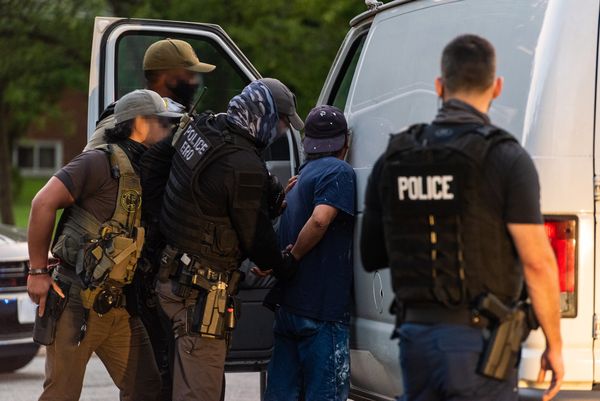
Student loan borrowers braved a cold snap on Tuesday to gather on the steps of the US supreme court as justices inside heard arguments for two crucial cases that could determine the fate of Joe Biden’s giant loan forgiveness program aimed at easing a financial burden for millions of Americans.
The president’s plan to clear up to $20,000 in debt for nearly 40 million student loan borrowers has hit several roadblocks since it was announced in August last year amid staunch Republican opposition that has taken to the courts to block it.
The most notable challengers are six Republican-led states – Arkansas, Iowa, Kansas, Missouri, Nebraska and South Carolina – that claim Biden greatly overstepped his authority by circumventing Congress to enact the debt relief plan now under scrutiny by the nation’s highest court.
Other challengers include Myra Brown and Alexander Taylor, two plaintiffs who filed a lawsuit in Texas, arguing that people like them would be harmed by Biden’s loan forgiveness plan since they would not benefit from it. Brown is not eligible for relief under the plan and Taylor is eligible for $10,000 in student debt relief, but not the full $20,000.
But in November, the Intercept reported that Brown, a small business owner, benefited from another pandemic-era loan forgiveness scheme called the paycheck protection program, in which $47,996 of loan debt for her business was forgiven.
Biden invoked the 2003 Heroes Act in order to cancel student loan debt, which gives the US secretary of education, Miguel Cardona, authority to make changes to any provision of the law applicable to student aid programs during national emergencies, like the aftermath of 9/11, or in this case, the Covid-19 pandemic.
The court’s decision that will determine if the debt relief plan can stand is expected from the justices on the 6-3 conservative majority court by late June. The plan, if it stands, could wipe out up to $400bn of student debt.
During the more than three-hour hearing Chief Justice John Roberts and his conservative colleagues questioned the Biden administration’s lawyer, Elizabeth Prelogar, about its authority to cancel federal student loans because of the pandemic.
“If you’re talking about this in the abstract, I think most casual observers would say if you’re going to give up that much … money. If you’re going to affect the obligations of that many Americans on a subject that’s of great controversy, they would think that’s something for Congress to act on,” Roberts said.
The main hope for Biden appears to be a slim possibility that the court would find that states and individuals challenging the scheme did not actually have the legal right to sue. One of the conservative justices, Amy Coney Barrett, appeared to some legal observers to be skeptical that the case had standing to be brought before the court.
Outside the court, protestors continued their demonstration as the hearing went on.
Congresswoman Sheila Jackson Lee, who represents Texas’s 18th district, told those gathered on the steps of the court: “The power is in us. We ask for nothing untoward. We ask for nothing that does not lift us up. We ask for what we deserve.”
Jackson added: “I’m with you, I support you. We are ready to move.”
The progressive Democratic congresswoman Rashida Tlaib said: “We’re not going to stop. We know the president of the US has every legal authority to cancel debt in our country.”
Leaders from organizations like the NAACP, labor unions representing educators and healthcare workers, and other debt relief advocacy organizations also showed up to the rally.
Mike Pierce, the founder and executive director of the Student Borrowers Protection Center – one of several advocacy organizations rallying – said he believed “the court will side with 40 million people”.
On the rightwing challenges to the loan relief plan, Pierce said: “This is just another example of Republican officials using the courts to play politics. These are President Biden’s political opponents. Canceling student debt is wildly popular, particularly with President Biden’s base.”
He added: “His political opponents are going to use every tool they have to try to prevent the president from governing successfully and standing on the side of Americans that are struggling under the weight of unaffordable student debt.”
Shanna Hayes, 34, was one of those borrowers attending the protest. She is a former math teacher who graduated with a master’s degree in 2015 with over $150,000 in loans. Because she was a Pell grant recipient for part of her education, Hayes might qualify for $20,000 in federal student loan forgiveness.
“My private loans, which we have been paying, you know, since the beginning of time – that payment is [already] around $430 a month, and that is only on about $30,000 in private loans.”
Federal student loan payments are paused while Biden’s plan is in limbo as the court decisions play out. A message prominently displayed at the top of the website of the office of federal student aid says: “The student loan payment pause is extended until the US Department of Education is permitted to implement the debt relief program or the litigation is resolved.”
Like millions of borrowers, Hayes is not making payments on her federal loans right now. For Hayes, who was recently laid off from her job in tech sales, the thought of even more hefty student loan payments every month is distressing. She also said the political fight over debt relief was likely to put off people from trying to go to college if they felt they could not afford it.
Hayes said: “We have attempted to do a lot in terms of student access to education and increasing access for students from marginalized communities, but we don’t necessarily support them in those endeavors. And part of that has to do with the amount of student loans that they have to take on to then be able to actually get those opportunities.”







